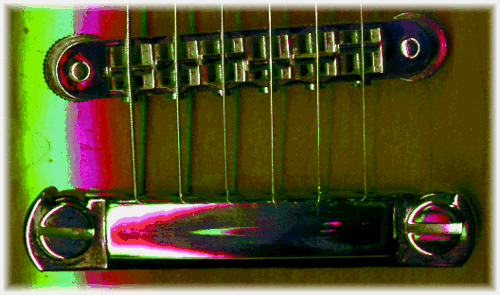Gibson Stop Tailpiece "Wrap"
The standard way of installing strings on a Gibson-style guitar which utilizes a stop tailpiece (Les Paul, V, ES335, etc.) is to run the strings from the back of the tailpiece, through the tailpiece, and then up and over the bridge like so:

An alternative is to run the strings from the front of the tailpiece, through the tailpiece, back up and over the top of the tailpiece, and then on over the bridge like so:

Benefits of the wrap include increased sustain (you can screw the tailpiece down to the guitar body), less string breakage (the angle at which the strings pass over the bridge is greatly reduced), easier bends (there is less string tension to fight due to the lessened angle over the bridge), and you have a very comfortable place to rest the heel of your hand when playing/muting.
The following is a comment by 'Guildx700~' from a thread on the Les Paul Forum regarding this mod:
Here's my answer about this copied from another thread, regarding string tension, stoptail height and such......
"Yes, the fact is...... it is 100% true a specific string requires a specific tension for a specific note.
Now....the saddle is normally the end of the strings length,
it is the fixed point that terminates the strings length, correct?
Yes, correct...until you bend or press on the string.
Now all bets are off, why?
Because the saddles are not "locking" saddles(like, say a locking nut) the string length behind the saddle now comes into play.
Don't believe me? Fret a note, keep it fretted...now pluck it's string length behind the saddle...NOW....while bending that fretted note continue to pluck its string length behind the saddle.
What happens? The pitch of the string length behind the saddle raises as you bend the fretted note.
What does that tell you?
That once strings are bent or even pressed down to fret(which essentially is a tiny micro bend) the string length behind the saddles now comes into play here and is now part of the strings overall bending tension equation.
Now with this in mind, consider....
1. If the tension of the string length behind the saddle is high already due to the stoptail being set down tight to the body causing a sharp angle on that short length of string, what is going to happen when you bend(or fret)a note? It's going to "access" that higher behind the saddle tension and feel stiff when you bend it.
2. Conversely, if the stoptail is raised up the tension on that short length of string is now low, so now when you bend a note the "access" to that lower behind the saddle tension causes the bend to feel less stiff.
Of course you don't get something for nothing here.
A higher stoptail will make fretting feel easier and bends easier, but....the distance needed to bend to a specific pitch will now be greater.
Make sense?
This is one reason why different guitar designs feel different, and react to bending notes differently.Tuned to concert pitch different guitars with the same string set, same scale length, will have the same tension at concert pitch. Right?
Right.
Now, each may feel like there's a different tension when fretted or bending though, why?
The string length that is on each end, each terminating point of the string, be it a nut or saddle varies on different guitar designs.
Headstock pitch, tuner spacing and height on the peghead as well as string trees, stop tail or trapeze, or frequensator tailpieces, through body stringing, or a Fender Strat or Tele type bridge...all of these have different behind the strings terminating point string length and tensions."
|

